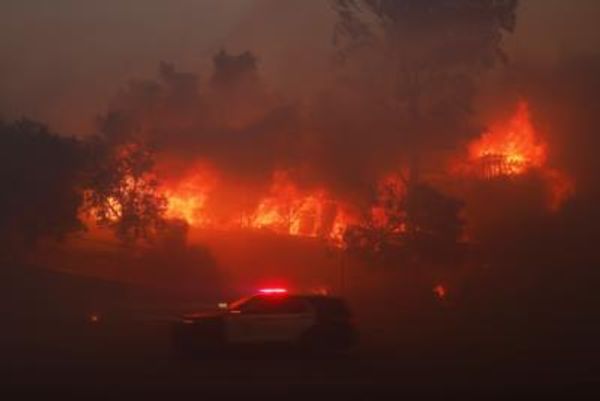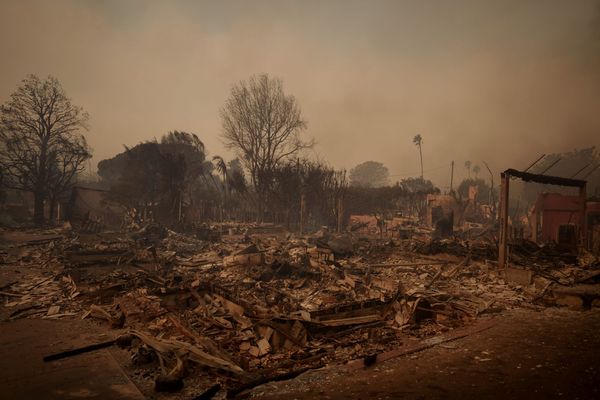
I halted the car behind an older man and a younger woman—shepherd and shepherdess—as they herded a dozen sheep along a narrow road in the mountain village of Irouléguy. Home to 385 residents, this village name is the same as that of the surrounding small wine appellation—with just over one square mile (265 hectares) of vines. This hilly and wet wine country is visually reminiscent of Jurançon, Monbazillac, Champagne, Cahors—even California’s Santa Ynez hills.
‘We are in the south, not the south-west of France,’ explained Michel Riouspeyrous, owner and winemaker of Domaine Arretxea as he looked out to surrounding peaks approximately 3,000 feet (1,000 meters) high. ‘The climate here is impacted by mountains, and also the Atlantic ocean which is 50 kilometers [30 miles] away. There is rain, humidity and cold mountain freshness here, and not a lot of alcohol in wines.’

Michel had driven us from his home to a nearby hilltop to visit remnants of an ancient stone priory as well as to look at surrounding peaks. He pointed out steep vineyards on a hill across a deeply sloped valley with century old white grape vines. Rain fell. Puddle water seeped through our shoes. Michel stayed oblivious to such normal working conditions.
‘It’s a small area with incredible history, and this is my project for life. I planted eight hectares [20 acres] and now with my two sons and others, we work on 12 hectares [30 acres]. It’s hard physical work here in the mountains. There is a lot of risk, including maybe death from a tractor accident. But a bottle of wine brings much to life: history, terroir, types of work, ecosystems, complexity.’
The Pyrenees peaks surrounding this wine valley provide shelter from both oceanic and northern winds. They also create warm downslope foehn winds in October, which hasten the ripening of grapes. Rainfall averages 70 inches (1,800 millimeters) a year, which is more than double that which falls on Bordeaux further north.

Agricultural production in the Irouléguy region centers around sheep and sheep’s milk cheeses, as well as pastoral cattle. There are also about a hundred vine growers supplying a wine cooperative, as well as 17 independent wine producers. Vineyards are 60% terraced and 60% organic. Some slopes are so steep that the phrase ‘heroic appellation’ applies because these vines are a brazen challenge to harvest by hand. A million bottles are produced annually here—making this wine low yield, high priced and sold in a niche market, which aligns with other local Basque food products that sell on reputation: Ossau-Iraty cheese, Piment d’Espelette pepper, Cerises d’Itxassou cherries and Porc Basque pigs. Similar to the also mountainous Jura region of France, Irouléguy is renowned for both its cheese and wine appellations.
Domaine Arretxea produces organic and biodynamic wines. Michel and his wife Thérèse use no chemical fertilizers, herbicides or insecticides. Their vineyards are surrounded by dozens of flora species which reduce erosion, aerate soils and fix trace elements. The prevailing rain and humidity make the grass here as lush green as any Irish pasture, forcing wine producers to mow their plots perhaps a half dozen times each year.

Irouléguy is located within France’s Basque territory—with its own language and cultural traditions independent from those of France or Spain. The Irouléguy region is also known as the ‘lower Navarre’ and sits on an ancient land of tanneries, pig farms and wool processing plants. This land between the towns of Saint-Étienne-de-Baïgorry and Saint-Jean-Pied-de-Port includes the Nive River, the Iraty Forest, and sloping hills often covered by morning mist.
The ancient town of Saint-Jean-Pied-de-Port—first constructed in the 7th century—was given a 12th century makeover by Sancho the Strong—King of the Navarre empire. The town includes red shuttered windows and carved wooden balconies and is surrounded by sheep pastures and stout stone farmhouses painted white. A ten-minute drive from Spain and forty minutes from the city of Bayonne, this town that was once a garrison is still a stopover along the Santiago de Compostela pilgrim route. For centuries it has been a market town and crossroads for commerce: at the indoor Monday market, wool capped and smiling bearded vendors sell earth coated potatoes and gorgeous loaves of tan colored bread, but stare with incredulity at strangers—few seen since the virus hit. The pink sandstone Notre-Dame-du-Bout-du-Pont church was built to commemorate victory over the Moors at Las Navas de Tolosa in the year 1212, and its entrance point, the Porte de Navarre, was once a toll point for those who entered the market.

Today, Saint-Jean-Pied-de-Port oozes with youth like a ski town, with eclectic and off-grid libertarian attitudes blending with more conservative mindsets, perhaps remnants from the centuries past kingdom of Navarre. Here, practicality meets décor. Footwear—colored teal and peach—is chic but practical; mountain shirt styles include lumberjack plaid, and hoodies are ubiquitous. Buff young men with misshapen haircuts and half-grown beards court youthful women strutting in hefty black designer boots, their athletic frames swathed beneath flamboyant wide scarves. Courtship here invariably revolves around food—particularly desserts such as small Basque cakes or meringue pies.
Cultural complexity suffuses through these rough hills. Even simple bars serve wine in quality stemware and basic ‘tapas’ can include cassolette de gambas (prawn potpourri) and accras de morue (Caribbean fritters). Barmaids wearing black masks and white platform shoes pull amber streams of beer before walls coated with photos of rugby teams.

Michel explained that the Irouleguy wine region extends six miles (10 kilometers) along an open valley that is protected and includes a rainy and humid microclimate conducive to growing vines. The varied local geology includes some 40 different soil types—including clay limestone, schist, ampelite and sandstone.
He and Thérèse first planted vines in 1993, and immediately used organic techniques. The early days were challenging.
‘Iroulèguy had a bad reputation. The banks didn’t give winegrowers money; the restaurants did not want our wines, and locals didn’t know about organic farming—so were prejudiced against it. It was my difficult time. Then Kermit Lynch from San Francisco visited in 1995, and began working with us. Also the Belgians—who were curious—began buying our wines. A two-star Michelin chef in the city of Bayonne tasted our white wines blind and was impressed. Before that, only Jurançon wines from this mountain region were known.’

Irouléguy white wines are made from three grapes: Gros Manseng (lively and citric), Petit Manseng (wide and aromatic) and Petit Courbu (providing minerality), while red wines are made from Tannat (giving color and tannic structure) and both Cabernet Franc and Cabernet Sauvignon (with suppleness, aromatics and complexity). Both Gros Manseng and Tannat have a reputation for pairing well with food, and regional fare will not disappoint: Irouléguy is a land of truffle pasta, Landes duck and heaping platters of warm charcuterie.
The white wines are particularly impressive with flinty aromas, crackling acidity and flavors both tropical and creamy. Many reds have earth and vegetal aromas and flavors of minestrone and plum. These are wines to match with food—garlic and seafood for whites, and hearty stews with reds.
As a winemaker, Michel stays aware of the forces he cannot control. ‘The big boss above brings rain, hail and frost.’
He also respects dedication to work he enjoys.
‘For almost thirty years I have had patience with time, working on quality, working with ecology and terroir. It is necessary to be humble, patient, focused. It is also important to love your work.’







